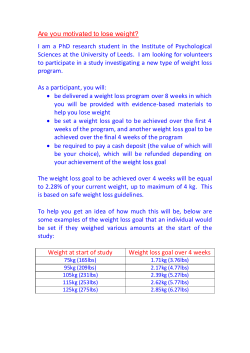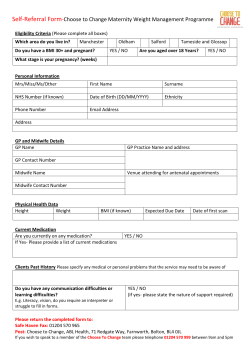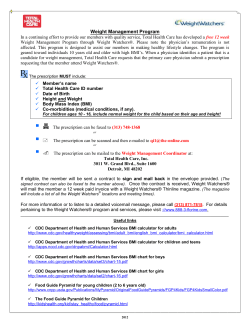
Disclosures Judith Korner, MD, PhD Obesity update • Covidien: Research Support
Judith Korner, MD, PhD Obesity update Disclosures Internal Medicine Review Columbia University June 3, 2013 • Covidien: Research Support Judith Korner, MD, PhD Associate Professor, Department of Medicine College of Physicians & Surgeons Director, Weight Control Center Columbia University Medical Center Objectives What is the definition of obesity? • Identify obesity related co-morbidities • Identify medications that may cause weight gain • Learn about non-pharmacologic therapies for weight loss • Learn about pharmacologic therapies for weight loss • Learn about surgical options for weight loss Case 1 19 yo male college student ADD; anxiety; PMH of pyloric stenosis and adenoidectomy Concerta; Zoloft; Allegra; Tetracylcine BMI ≥ 25 kg/m2 = Overweight BMI ≥ 30 kg/m2 = Obese BMI ≥ 40 kg/m2 = Morbid Obesity Case 2 36 yo man with T2DM x 4 y, HTN, gout, hypercholesterolemia, GERD, obstructive sleep apnea PMH: seasonal allergies had previously lost 90lb with subsequent regain Meds: Levemir 60u qhs Propranolol 80 mg bid Byetta 10 mcg bid HCTZ 25 mg qd Metformin 1000 mg bid Lisinopril 40 mg qd Glipizide 10 mg bid Amlodipine 10 mg qd Frustrated with wt loss attempts Niaspan 500 mg qd Prilosec Simvastatin 20 mg qd ECASA 81 mg qd Wt 368.4 lb; BMI 48.6 Trilipix (Fenofibrate) 145 mg qd Zyrtec, Vit D3, Nasonex Lovaza 4 tabs qd Allopurinol 300 mg qd Fasting glucose 92; insulin 55; HbA1c 5.4 CPAP (poor compliance) Judith Korner, MD, PhD Medical Complications of Obesity Case 2 cont’d Vitals: Wt: 295 lb Ht: 72.4” abnormal function obstructive sleep apnea hypoventilation syndrome BMI: 39.5 BP: Idiopathic intracranial hypertension Pulmonary disease 106/65, Stroke Cataracts Nonalcoholic fatty liver disease Pulse: 68 reg Coronary heart disease Diabetes Dyslipidemia Hypertension GERD Severe pancreatitis steatosis steatohepatitis cirrhosis LABS: Gall bladder disease glucose 164 Cancer Gynecologic abnormalities breast, uterus, cervix colon, esophagus, pancreas kidney, prostate abnormal menses infertility polycystic ovarian syndrome HbA1c 9.9% TC 155; LDL 78; HDL 27; TG 249 AST 39; ALT 48 Osteoarthritis creatinine 1.2; urine microalbumin 289 ug/mg creatinine Phlebitis venous stasis Skin Gout Relationship Between BMI and Comorbidities is Positive, Even in the “Normal” Range Age-Adjusted Relative Risk Relationship Between BMI and Risk of Type 2 Diabetes 93.2 Type 2 diabetes Cholelithiasis Hypertension Coronary heart disease Men Men Women Women 54.0 42.1 40.3 27.6 1.0 2.9 1.0 4.3 1.0 5.0 1.5 <22 <23 23 23.9 24 24.9 8.1 2.2 15.8 25 26.9 27 28.9 4.4 6.7 21.3 11.6 6 6 5 5 4 4 3 3 2 2 1 29 30.9 31 32.9 33 34.9 35+ Body Mass index (kg/m2) Chan J et al. Diabetes Care 1994;17:961. Colditz G et al. Ann Intern Med 1995;122:481. 1 0 0 <21 22 23 24 25 26 27 28 29 30 Body Mass Index (kg/m2) 22 23 24 25 26 27 28 29 30 Body Mass Index (kg/m2) Willett WC, et al. N Engl J Med. 1999;341:427-434. Slide Source: www.obesityonline.org How to Measure Waist Circumference Physical Exam •Vitals (use appropriate size BP cuff ) ● Place a measuring tape, held parallel to the floor, around the patient’s abdomen at the level of the iliac crest •Height, Weight, Calculate BMI (kg/m2) wt (lb) x 703 ht (in2) <21 Overweight ≥ 25 Obese ≥ 30 ● The tape should fit snugly around the waist without compressing the skin •Measure waist circumference (>35 inches for women; >40 inches for men) ● Take the measurement at the end of a normal expiration •Skin changes: acanthosis nigricans, pigmented striae A waist circumference of ≥40 inches in men or ≥35 inches in women is diagnostic of abdominal obesity and suggests the presence of other cardiometabolic risk factors. Adapted from Grundy SM, et al. Circulation. 2005;112:2735-2752. 12 Judith Korner, MD, PhD Laboratory Tests Forget about Barbie •Biochemistry Profile •Thyroid Profile •Lipid Profile •Fasting Insulin and Glucose Consider insulin resistance if insulin > 10U/ml or glucose is >95 mg/dl •EKG • Barbie’s projected human measurements: 39-18-33 • Average white woman: age 18-25: 38-32-41 age 36-45: 41-34-43 •If clinical suspicion of Cushing’s - 24 hr UFC •If clinical suspicion of PCOS - androgen profile •If clinical suspicion of sleep apnea - sleep study Cornerstone of Weight Loss Treatment Behavior Therapy • Self-monitoring includes recording dietary intake (food choices, amounts, times), exercise and changes in body weight. • Stimulus control - identify and change cues that are associated with eating too much and exercising too little. For example, limiting exposure to food or separating eating from other activities such as reading or watching television. • Reinforcement encourages attainment of difficult to achieve goals. Reinforcement may come from a social support network or getting nonfood rewards for reaching goals. • Stress management helps coping with stressful events by developing outlets besides eating for reducing stress. Evaluating setbacks and determining how to do better next time can break the chain of negative thinking and self-punishment when lapses occur. • Behavior Therapy, Diet, Exercise Behavioral Mechanisms: Is Extreme Ravenousness Required? Obesity Trends* Among U.S. Adults BRFSS, 1990, 2000, 2010 (*BMI 30, or about 30 lbs. overweight for 5’4” person) 2000 1990 2 oz chocolate bar 20 oz cola Total = = = 260 kcal 252 kcal 512 kcal 2010 Weight gain: 1 lb/week No Data Forbes GB, et al. Br J Nutr. 1986;56:1-9. Allison DB, et al. Am J Psychiatry. 1999;156:1686-96. <10% 10%–14% 15%–19% 20%–24% Source: Behavioral Risk Factor Surveillance System, CDC. 25%–29% ≥30% Judith Korner, MD, PhD Long-Term Weight Loss: Non-Pharmacologic Treatment A Guide to Selecting Treatment: National Institutes of Health (NIH) Guidelines* Body Mass Index (BMI) (kg/m2) Treatment Diet, physical activity, behavior therapy 25–26.9 27–29.9 30–34.9 35–39.9 ≥40 Yes with comorbidities Yes with comorbidities Yes Yes Yes Yes with comorbidities Yes Yes Yes Yes with comorbidities Yes Pharmacotherapy Weight-loss surgery VLCD: ≤800 kcal/day BMOD: behavior + 1200kcal/day Combined: VLCD + behavior *Yes alone indicates that the treatment is indicated regardless of the presence or absence of comorbidities. The solid arrow signifies the point at which therapy is initiated. Wadden Annals of Int Med 119:688 1993 NIH/NHLBI, NAASO. The Practical Guide: Identification, Evaluation, and Treatment of Overweight and Obesity in Adults. Bethesda, Md: NIH; 2000. Drugs that May Promote Weight Gain Drugs that Cause Little or No Weight Gain or Weight Loss Antidepressants – Bupropion – Venlafaxine Antiepileptic drugs – Topiramate – Lamotrigine – Zonisamide Antipsychotics – Ziprasidone – Aripiprazole Paroxetine (n = 47) Sertraline (n = 48) Fluoxetine (n = 44) * Antidepressants – Paroxetine – Mirtazapine – MAOIs, TCAs Antiepileptic drugs – Valproate – Gabapentin Antipsychotics – Clozapine, olanzapine, risperidone, quetiapine Lithium Mean % Change in Body Weight Different Long-Term Effects of SSRIs on Body Weight †P = .015 †P < .001 % Incidence of >7% Weight Gain CNS Drug-Induced Weight Gain †P †P < .003 Analysis is for treatment responders MAOIs = monoamine oxidase inhibitors; TCAs = tricyclic antidepressants. *P < .001 compared to baseline, †P-values for comparison to paroxetine Fava M, et al. J Clin Psychiatry. 2000;61:863-7. Impact of Anti-Diabetic Therapies on Weight GAIN Sulfonylurea Glinide TZDs Insulin NEUTRAL Metformin Orlistat Mechanism of Action LOSS GLP-1 agonist Alpha-Glucosidase Pramlintide Inhibitor DPP4-Inhibitor Nathan et al Diabetes Care 31:1-11, 2008 30% of fat not absorbed < .016 Judith Korner, MD, PhD Weight Change Over 104 Weeks Weight Loss (%) 0 Placebo Orlistat Diet Hypocaloric Eucaloric 4.5% 5 8.1%* 10 Orlistat Safety • The most common side effects include abdominal discomfort, oily spotting, flatuence with discharge, fecal urgency and incontinence. • Absorption of fat-soluble vitamins and some medications (eg. cycolsporine) may be affected. 13 0 15 30 45 *P < 0.05 (vs placebo). Sjöström L, et al. Lancet. 1998;352:167172. 60 75 90 104 Week Noradrenergic Agents • Schedule IV drugs have a low potential for abuse • Phentermine (Adipex-P, Fastin): 18.75-37.5 mg/day • Phentermine resin (Ionamin): 15-30 mg/day • Diethylpropion (Tenuate, Tenuate Dospan): 25 mg 3x/day or sustained release 75 mg/day • Phenylpropanolamine (Dexatrim, Acutrim): withdrawn from market due to association with hemorrhagic stroke • Liver failure? Noradrenergic Agents (cont’d) • Approved by the FDA for short-term use: ~ 3 months • Studies show between 2-10 kg weight loss over placebo • Side effects: insomnia, dry mouth, constipation, euphoria, palpitations, hypertension Yanovski NEJM 346:591 2002 Lorcaserin (Belviq): Serotonin receptor 5-HT2c Agonist (no valvulopathy) Model of a weight-regulating feedback system Hypothalamus Vagus Nerve Gut and Liver Smith SR et al. N Engl J Med 2010;363:245-256 Autonomic Nervous System External Factors food availability, palatability Insulin Pancreas Leptin Adipose Tissue Adrenal Steroids Adrenal Cortex Aronne LJ. Adapted from Campfield LA, et al. Science. 1998;280: Meal Size Energy Balance and Adipose Stores Food Intake Energy Expenditure 1383-1387; and Porte D, et al. Diabetologia. 1998;41:863-881. Judith Korner, MD, PhD Randomized, placebo-controlled extension study of controlled release phentermine/topiramate (Qnexa/Qsymia) Adverse events: nephrolithiasis, hypokalemia, paresthesia, dysgeusia, constipation, insomnia, dry mouth, depression, anxiety , irritability, disturbance to attention, CLEFT PALATE Garvey et al, AJCN 2012,95:297-308 Naltrexone + Bupropion (Contrave) Greenway et al, Lancet 376:595-605, 2010 Judith Korner, MD, PhD Diabetes Prevention Program Research Group Average Wt Loss Placebo: 0.1 kg Metformin: 2.1 kg Does lifestyle intervention or administration of metformin prevent or delay the development of diabetes? Lifestyle: 5.6 kg 50% ≥7% at 24 wk 38% ≥ 7% at most recent visit Decrease in daily energy intake Placebo: 249 kcal Metformin: 296 kcal Lifestyle: 450 kcal Eligibility Criteria •3234 nondiabetic persons •Elevated fasting glucose (95-125 mg/dl) and •Elevated glucose 2h after 75g glucose load (140-199 mg/dl) •BMI ≥ 24 (≥ 22 in Asians) NEJM 346:393 2002 Diabetes Prevention Program – Modest Weight-Loss Reduces the Incidence of New-Onset Diabetes in an At-Risk Population ADJUSTABLE GASTRIC BAND Weight loss Cumulative Incidence of Diabetes (%) 40 Decrease in risk* 0.1 kg Placebo 30 Metformin 20 2.1 kg 31% 5.6 kg 58% Lifestyle 10 0 0 1 2 3 4 Years P<0.001 for each comparison. *Decrease in risk of developing diabetes, compared to placebo group. Diabetes Prevention Program Research Group. N Engl J Med. 2002;346:393-403. Remission of DM Gluttonous Hedonistic Buchwald et al, JAMA 2004; 292:1724-37 Sjöström et al, NEJM 2004; 351:2683-93 ROUX-EN-Y GASTRIC BYPASS SLEEVE GASTRECTOMY Judith Korner, MD, PhD Badman and Flier, 2005, Science 307:1909 Korner et al, SOARD, 2007 3:597-601 Case 1 lost 80 lbs (22% of body weight) 19 yo male college student ADD; anxiety; PMH of pyloric stenosis and adenoidectomy Concerta; Zoloft; Allegra; Tetracylcine Frustrated with wt loss attempts Wt 368.4 lb; BMI 48.6 Fasting glucose 92; insulin 55; HbA1c 5.4 Glucose 92 HbA1c 5.4 Insulin 55 91 5.1 14 Case 2 Month 6 post Bypass BMI 32 36 yo man with T2DM x 4 y, HTN, gout, hypercholesterolemia, GERD, obstructive sleep apnea PMH: seasonal allergies HbA1c 5.5% TC 116, LDL 63, HDL 28, TG 124 had previously lost 90lb with subsequent regain 80 Meds: Levemir 60u qhs Propranolol 80 mg bid Byetta 10 mcg bid HCTZ 25 mg qd Metformin 1000 mg bid Lisinopril 40 mg qd Glipizide 10 mg bid Amlodipine 10 mg qd Niaspan 500 mg qd Prilosec Simvastatin 20 mg qd ECASA 81 mg qd Trilipix (Fenofibrate) 145 mg qd Zyrtec, Vit D3, Nasonex Lovaza 4 tabs qd Allopurinol 300 mg qd CPAP (poor compliance) Cozaar 100 mg Toprol XL 50 mg Amlodipine 5 mg Allopurinol 300 mg Zyrtec Ca, Vit D, Fe, MVI, B12 Lost 66 lb (22%) in 9 months Judith Korner, MD, PhD VACU-PANTS Lose Weight While You Sleep lose inches off your waist in days DIET AIDS I lost 12 pounds in 5 days and ate anything I wanted Exercise in a Bottle Weight Reduction: Pharmacotherapy – – – – – – Initiate when weight goals are difficult to achieve or maintain through diet and physical activity Set realistic goals Administer for the long term Always use in conjunction with diet, physical activity, and behavior therapy Future therapies may target specific pathways Future therapies may involve a “cocktail” of different medications targeting different pathways Disparagement of obese individuals is “the last socially acceptable form of prejudice.” Stunkard and Sobal, 1995 Thank you
© Copyright 2025


















